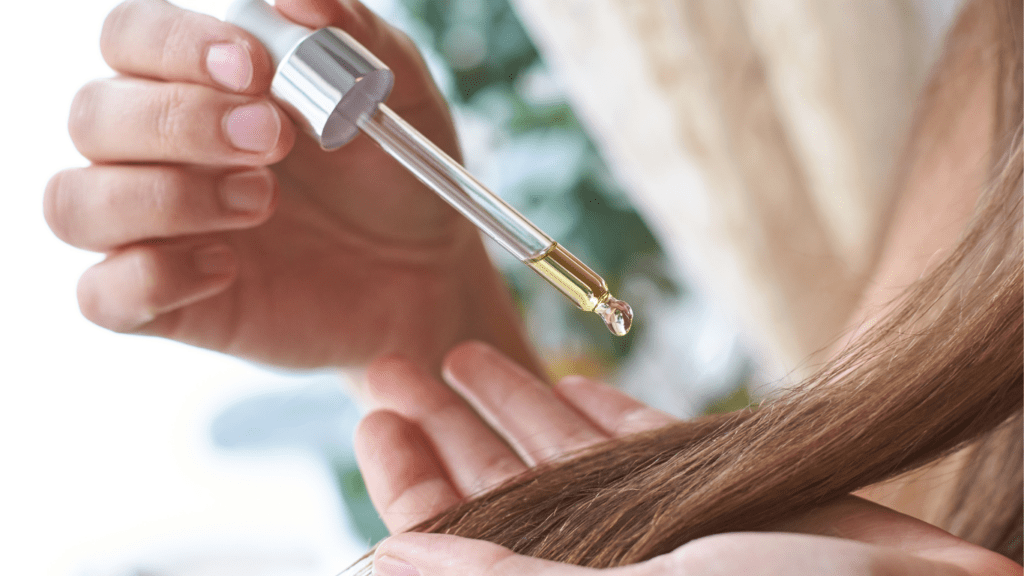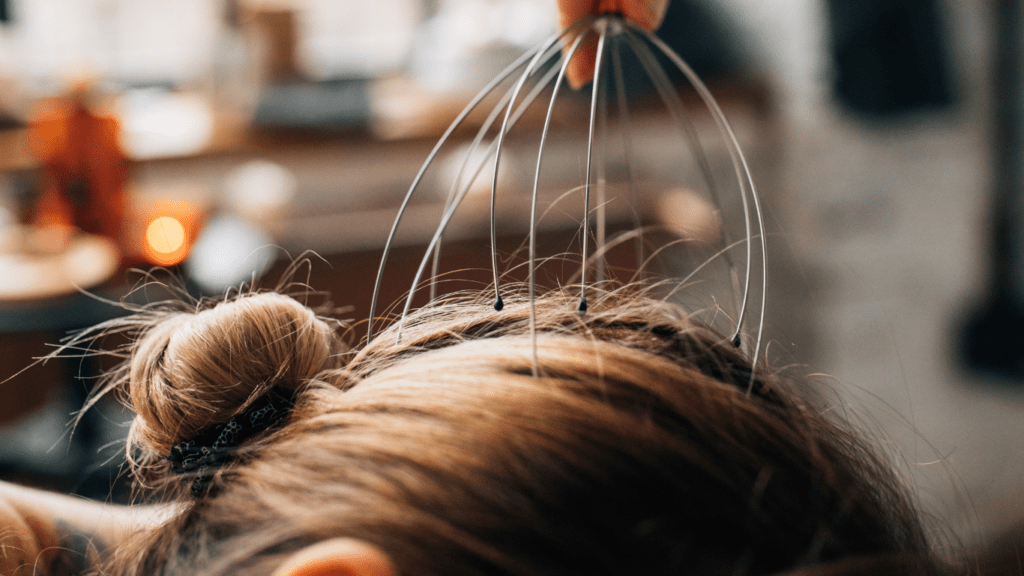The Basics of Hair Serums
Understanding the fundamentals of hair serums helps in selecting the right product. Hair serums are silicone- or oil-based solutions that coat the surface of the hair. Silicones such as dimethicone and cyclopentasiloxane create a smooth, glossy layer, reducing frizz and enhancing shine. Natural oils like argan and jojoba oil provide nourishment, adding hydration and strength.
Application techniques are crucial for optimal results. Apply a few drops to damp hair, focusing on the mid-lengths and ends. Avoid the roots to prevent a greasy appearance. Use a wide-tooth comb to distribute the serum evenly. Heat activation from styling tools can enhance the serum’s effectiveness, making it essential when blow-drying or straightening.
Hair serums serve different purposes based on their formulations. Anti-frizz serums tame dry and unruly hair, while shine serums boost the natural luster of dull hair. Repair serums target damaged strands with ingredients like keratin and amino acids, promoting stronger, healthier hair. Color-protect serums help maintain vibrancy in dyed hair, preventing fading due to UV exposure and washing.
By understanding these elements, I can make informed choices about hair serum products that fit my hair type and needs, ensuring healthier and shinier hair.
Key Ingredients in Hair Serums
Understanding the key ingredients in hair serums helps you choose the best product for your hair type and concerns. Here are some essential components often found in hair serums.
Silicones
Silicones offer multiple benefits in hair serums by providing a protective layer. Cyclopentasiloxane and dimethicone, common silicones, coat the hair strand to lock in moisture and reduce frizz. These elements also make hair appear shinier and smoother by filling in surface irregularities. Silicones can aid in detangling hair, especially for those with curly or wavy textures.
Natural Oils
Natural oils enrich hair serums with nourishing properties. Argan oil and jojoba oil are popular choices for their hydrating and restorative attributes. They penetrate the hair shaft, offering deep conditioning and improving hair elasticity. Rich in vitamins and fatty acids, these oils enhance hair strength and prevent breakage, making them ideal for dry or damaged hair types.
Protein Complexes
Protein complexes in hair serums strengthen and repair weakened hair structures. Keratin and silk protein are notable examples. Keratin, the primary protein in hair, helps rebuild and restore the hair’s natural structure, aiding in repair and protection. Silk protein adds softness and manageability, making it easier to style and maintain. Protein complexes are beneficial for chemically treated or heat-damaged hair.
Understanding these components ensures you select a hair serum that meets your specific hair needs.
How Hair Serums Work
Hair serums transform hair appearance by addressing various common issues. They condition, smooth, and protect hair against damage.
Moisturizing Properties
Hair serums contain moisturizing ingredients like silicones and oils. These elements lock in moisture, preventing dryness and frizz. Silicones, such as dimethicone and cyclomethicone, create a barrier that seals moisture within the hair shaft. Oils like argan and jojoba hydrate the hair, making it supple and resilient. By penetrating the hair cuticle, moisturizers improve hair elasticity and manageability.
Smoothing Effects
Smoothing ingredients in hair serums enhance shine and reduce frizz. Silicones, seen in serums, form a thin, protective layer around each hair strand. This layer smooths the hair cuticle, minimizing roughness and static. Natural oils, like coconut and almond, provide similar smoothing benefits. These components ensure hair appears sleek, polished, and well-managed throughout the day.
Heat Protection
Hair serums also offer heat protection, essential for anyone using heat styling tools. Silicones in the serums withstand high temperatures, acting as a barrier that shields the hair from direct heat damage. Ingredients like grapeseed oil and keratin fortify hair by enhancing its structural integrity. This protection reduces the risk of cuticle damage and split ends, maintaining healthier hair after styling with heat tools.
Benefits of Using Hair Serums

Hair serums offer numerous benefits that enhance various aspects of hair health and appearance. They play a crucial role in improving hair texture, reducing frizz, and enhancing shine.
Improved Hair Texture
Hair serums improve hair texture by smoothing the hair cuticle. Silicones and oils coat each strand, making hair feel silky. Protein complexes strengthen hair, reducing brittleness. The result is softer, more manageable hair that feels and looks healthier.
Reduced Frizz
Hair serums significantly reduce frizz. They form a protective barrier that locks in moisture. This barrier prevents external humidity from causing frizz. Ingredients like:
- argan oil,
- silicone
- keratin
tame flyaways, creating a sleek, polished look.
Enhanced Shine
Hair serums enhance shine by reflecting light off the hair’s smooth surface. Natural oils like jojoba and almond oil add luster. Silicones create a glossy finish. This radiant effect amplifies the overall appearance of vibrant, healthy hair.
Choosing the Right Hair Serum
Understanding your hair type and specific needs is crucial when selecting the right hair serum. Let’s delve into the main considerations.
Hair Type Considerations
Different hair types require different formulations. For instance, curly hair benefits from serums with additional moisture and frizz control. Fine hair suits lightweight serums to avoid weighing down. Color-treated hair needs color-protective serums with UV filters to prevent fading. Identifying your hair type makes serum selection more effective.
Ingredient Preferences
Ingredients determine a serum’s effectiveness. For dry hair, choose serums with argan oil, glycerin, or coconut oil for added hydration. Oily hair benefits from non-greasy options like silicone-based serums that control shine without buildup. Damaged hair responds well to keratin and protein-infused serums that repair and strengthen. Reading ingredient lists assists in making informed choices.
Brand Recommendations
Several reputable brands offer quality hair serums. Some top-rated brands include:
| Brand | Key Features |
|---|---|
| Olaplex | Repairs and strengthens |
| Moroccanoil | Rich in argan oil |
| Paul Mitchell | UV protection |
| Biosilk | Silk protein-infused |
Brand reputation, reviews, and specific hair concerns guide these recommendations. Trusting established brands ensures reliable results and improved hair health.
Choosing the right hair serum depends on understanding various factors, including hair type, ingredient preferences, and trusted brands. This knowledge helps achieve desired hair outcomes.
Application Tips for Optimal Results
Using hair serums correctly ensures you reap their full benefits. Here are essential tips to maximize their effectiveness.
Correct Amount to Use
Less is often more with hair serums, depending on hair length and thickness. For short hair, use a pea-sized amount. For medium-length, a dime-sized amount suffices. Long hair may require a nickel-sized amount. Overusing serum can lead to a greasy look. Always start with a small amount and add more if needed.
Best Time to Apply
Apply serum on damp hair after washing for best absorption. Serums protect hair from heat styling and environmental damage. However, if you use it on dry hair, focus on the ends to tame frizz and add shine. Avoid applying to roots to prevent an oily scalp.
Techniques for Even Distribution
To ensure even distribution, rub the serum between your palms before application. Start at the ends, where hair tends to be drier, and work your way up. Use a wide-tooth comb to distribute the product evenly. For curly hair, scrunch the serum into the hair to define curls and reduce frizz.



 Product Review Expert
Marta is the product guru of the team, with a keen eye for discovering the best hair care products available. She meticulously tests and reviews shampoos, conditioners, styling tools, and treatments to give readers honest, in-depth insights. Marta’s expertise ensures that only the highest quality products are recommended, making her reviews an essential guide for anyone looking to invest in their hair care routine.
Product Review Expert
Marta is the product guru of the team, with a keen eye for discovering the best hair care products available. She meticulously tests and reviews shampoos, conditioners, styling tools, and treatments to give readers honest, in-depth insights. Marta’s expertise ensures that only the highest quality products are recommended, making her reviews an essential guide for anyone looking to invest in their hair care routine.
